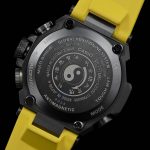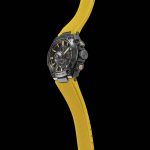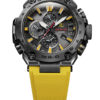G-SHOCK launches new collaboration model with action film and martial arts legend Bruce Lee, who would have turned 80 this year 2020. To mark the occasion, the Japanese brand is celebrating a legendary icon like Bruce Lee, who always overcame his limits to become one of the undisputed champions in fighting. The new G-SHOCK MRG-G2000BL is a combination of top-quality materials, construction, workmanship and finishes that highlight the physical and mental strength of the champion to whom it is dedicated; qualities that still fascinate audiences today, transcending generations. The colours black and yellow are used for the case and strap, respectively, and recall the iconic suit worn by Bruce Lee in his last unfinished film. In addition, the colours yellow and red, which appear in the symbol of Jeet Kune Do, the philosophical martial art founded by Lee, are used, respectively, for the hour markers, the MR-G logo and the seconds hand. The entire design of the watch echoes the philosophical thinking behind Jeet Kune Do and the philosophy of its creator, Bruce Lee. The bezel is engraved with the phrase "No way as a way, no limit as a limit" expressing the infinite potential of Jeet Kune Do, while its symbol, with the same phrase in Chinese, is engraved on the case back. On the dial at 3 o'clock is Bruce Lee's signature written in the Chinese character "龍", meaning dragon, its nickname. The new MRG-G2000BL will be sold in only 200 pieces worldwide.
BRUCE LEE
Lee Jun-fan (Chinese: 李振藩; 27 November 1940 - 20 July 1973), stage name Bruce Lee (Chinese: 李小龍), was a Chinese-American actor, director, martial arts instructor and philosopher. Lee founded Jeet Kune Do, a hybrid martial art and philosophy inspired by several combat disciplines and often credited with paving the way for modern mixed martial arts (MMA). Lee is considered to be one of the most influential commentators, critics, supporters and martial arts masters of all time, a 20th century pop culture icon who managed to bridge the gap between East and West. He is often credited with helping to change the way Asians were presented in American films.













